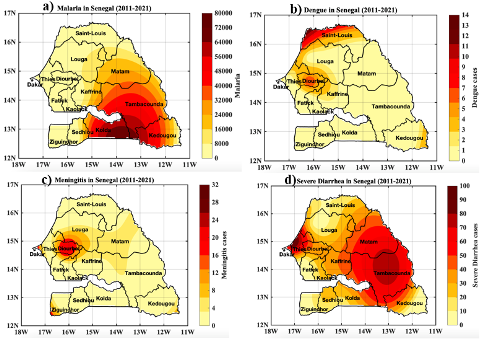An overview of Climate Change Impacts on the Health Sector for the Research Program of the National Adaptation Plan Support Project in Senegal
- Post by: SOAPHYS-KZ
- 23 janvier 2024
- Comments off


http://dx.doi.org/10.46411/jpsoaphys.2023.016
Section de la parution: Informations de publication
J. P. Soaphys, Vol 3, N°2 (2023) C23N22
Pages : C23N22-1 à C23N22-13
Informations sur les auteurs
An overview of Climate Change Impacts on the Health
Sector for the Research Program of the National Adaptation Plan Support Project
in Senegal
Diouf I.1,*, Sy I.2,
Diouf D.1, Ndione J.-A. 3, Gaye A.T.1
1Laboratoire de Physique de l’Atmosphère et de l’Océan-Siméon Fongang, Ecole Supérieure Polytechnique de l’Université Cheikh Anta Diop (UCAD), Dakar–Fann BP 5085, Senegal.
2 Département de Géographie, Faculté des Lettres et Sciences Humaines (FLSH), Université Cheikh Anta Diop (UCAD) & Centre de Suivi Ecologique (CSE), Dakar, Sénégal
3 Regional Agency for Agriculture and Food) 83 Rue des Patures (Super Taco), 01 BP 4817 – Lomé
* Corresponding
author email: ibrahima23.diouf@ucad.edu.sn
RESUME
Senegal, a coastal country in the semi-arid Sahel region, faces significant risks associated with climate variability and climate change. Climate change is already affecting vulnerable people’s wellbeing and it’s expected to contribute to the (re)emergence of vector-borne, some water-borne and heat-related diseases, which will have disastrous consequences on the country’s fragile health system and socio-economically vulnerable population. Our contribution to the National Adaptation Plan support Project – Global Environment Fund (NAP-GEF) aims to support community- based epidemiological surveillance and the design/maintenance of health information systems in order to improve planning, decision-making, and public health response. Our methodological approach aims to build a detailed climate and health database to describe the spatio-temporal characteristics of the climate-health relationships at national scale. Considering various indices of targeted diseases, we assess the degree of transmission of those diseases in Senegal for different historical period (1950-2014 and projections (2015-2100) based on a combination of the Shared Socio-Economic Pathways (SSPs) produced within the Coupled Model Intercomparison Project, phase 6 (CMIP6). Selected diseases include malaria, meningitis, dengue and Chronic – non communicable to heat waves. The project will strengthen institutional capacity to mainstream climate related risks within the Ministry of Health’s strategies and governance model, enabling a public health system framework to support long-term and sustainable adaptation funding and programs. The project is being implemented jointly with the Ministry of Environment and Sustainable Development (MEDD) and the Ministry of Health and Social Action (MSAS). The findings in the project will guide and operationalize community-based early-warning systems and adaptation strategies specific to local climate-sensitive diseases in targeted regions in Senegal, which will feed into the national health prevention, response, and care strategies adapted to the needs of local communities. Development of scientific evidence and a knowledge management system get started in this study about the links between climate change and health through the launch of studies in collaboration with research institutions. However, barriers or limitations to integrating climate change data and information into health policies have also been identified
Mots-Clés : Climate variability and Climate Change, Projections, Impacts, Health, diseases, Senega
Adhikari S.P., Meng S., Wu Y-J, Mao Y-P., Ye
R-X., Wang Q-Z, et al., 2020. Epidemiology, causes, clinical
manifestation and diagnosis, prevention, and control of coronavirus disease
(COVID-19) during the early outbreak period: a scoping review. Infect Dis Poverty ;9: 1–12.
Akaike H.,
1974. A new look at the statistical model identification. IEEE Trans. Autom. Control. 19: 716–23.
Bhatt S.
et al., 2013. The global distribution and burden of dengue. Nature,
496(7446), 504-507.
Brady, Oliver J., et al., 2012.
Refining the global spatial limits of dengue virus transmission by
evidence-based consensus, PLOS Neglected Tropical Diseases 6(8): p.
e1760.
Chen, N., Zhou, M., Dong, X., Qu, J.,
Gong, F., Han, Y., … & Yu, T., 2020. Epidemiological and clinical
characteristics of 99 cases of 2019 novel coronavirus pneumonia in Wuhan,
China: a descriptive study. The Lancet,
395(10223), 507-513.
Cissé, G., R. McLeman, H. Adams, P. Aldunce, K. Bowen, D. Campbell-Lendrum, S.
Clayton, K.L. Ebi, J. Hess, C. Huang, Q. Liu, G. McGregor, J. Semenza, and M.C.
Tirado, 2022: Health, Wellbeing, and the Changing Structure of Communities. In:
Climate Change 2022: Impacts, Adaptation and Vulnerability. Contribution of
Working Group II to the Sixth Assessment Report of the Intergovernmental Panel
on Climate Change [H.-O. Pörtner, D.C. Roberts, M. Tignor, E.S. Poloczanska, K.
Mintenbeck, A. Alegría, M. Craig, S. Langsdorf, S. Löschke, V. Möller, A. Okem,
B. Rama (eds.)]. Cambridge University Press, Cambridge, UK and New York, NY,
USA, pp. 1041–1170, doi:10.1017/9781009325844.009.
Dee, D. P., Uppala, S. M., Simmons, A. J.,
Berrisford, P., Poli, P., Kobayashi, S., … & Vitart, F., 2011. The
ERA-Interim reanalysis: configuration and performance of the data assimilation
system. Quart J Roy Meteor Soc 137:
553–597.
Diouf I., Deme, A., Ndione, J-A., Gaye A.T
and Rodriguez-Fonseca, B., 2013. Climat-santé: observation et
modélisation du paludisme au Ferlo du Sénégal. Comptes rendus. Biologies, 336(5-6), 253-260.
Diouf I., Fonseca B.F., Deme, A., Caminade
C., Morse A.P., Cisse M., Sy, I., Dia I., Ermert V., Ndione J.A. and Gaye A.T.,
2017. Comparison of malaria simulations driven by
meteorological observations and reanalysis products in Senegal. International journal of environmental
research and public health, 14(10), p.1119.
https://doi.org/10.3390/ijerph14101119.
Diouf I., Rodríguez-Fonseca B.R., Caminade
C., Thiaw W.M., Deme A., Morse, A.P., Ndione J.A., Gaye A.T., Diaw A. and
Ndiaye M.K.N., 2020. Climate Variability and Malaria over West Africa. The American Journal of Tropical Medicine
and Hygiene, 102(5),pp.1037-1047. https://doi.org/10.4269/ajtmh.19-0062
Diouf I., Gbenga J.A, Abiodun M.A,
Christopher L., Joyce M.S, Pascal Y., Ndione J-A, and Emiola O.G, 2021b. Impact
of future climate change on malaria in West Africa, Theoretical and Applied
Climatology. vol. 147, no 3, p. 853-865.
Diouf I., Suárez-Moreno R.,
Rodríguez-Fonseca B., Caminade C., Wade, M., Thiaw M.W, Deme A., Morse, A.P.,
Ndione J.-A., Gaye A.T, Diaw A., and Ndiaye M.K.N., 2021. Oceanic Influence on
Seasonal Malaria Incidence in West Africa. Weather, Climate, and Society. vol.
14, no 1, p. 287-302.
Eyring, V., Bony, S., Meehl, G. A.,
Senior, C. A., Stevens, B., Stouffer, R. J., and Taylor, K. E, 2016. Overview
of the Coupled Model Intercomparison Project Phase 6 (CMIP6) experimental
design and organization, Geosci. Model Dev., 9, 1937-1958,
doi:10.5194/gmd-9-1937-2016.
Ermert, V., A.H. Fink, A.E. Jones, A.P
Morse, 2011: Development of a new version of the Liverpool Malaria Model. I.
Refining the parameter settings and mathematical formulation of basic processes
based on a literature review. Malar.
J., 10, 35.
Faye M., Dème
A., Diongue A. K., & Diouf, I., 2021. Impact of different
heat wave definitions on daily mortality in Bandafassi, Senegal. PloS one, 16(4), e0249199.
Gao J.,
Sun Y., Liu Q., Zhou M., Lu Y., Li L., 2015. Impact of extreme high temperature
on mortality and regional level definition of heat wave: A multi-city study in
China. Science of the Total Environment
505, 535–544. pmid:25461056
Gasparrini A., Armstrong B., 2011. The impact of heat waves on
mortality. Epidemiology 22 (1):
68–73. pmid:21150355
Hastie
T.J., Tibshirani RJ., 1990. Generalized Additive Model, London UK: Chapman and
Hall.
Hersbach, H.; Bell, B.;
Berrisford, P.; Hirahara, S.; Horányi, A.; Muñoz-Sabater, J.; Nicolas, J.;
Peubey, C.; Radu, R.; Schepers, D.; et al., 2020. The ERA5 Global Reanalysis. Q.
J. R. Meteorol. Soc., 146, 1999–2049.
Hoshen, M.B.; Morse, A.P., 2004. A
weather-driven model of malaria transmission. Malar. J., 3, 32.
Jeanne I., Rajot J. L., Defossey A., Kairo
K. K., Kalache M ., Boisier P., 2005. Dust events and meningitis cases
during the dry season (November to April) in the Sahel from 1995 to 2005:
methodology for temporal and spatial analysis. 1st international AM M A conference, 2 December 2005, Dakar,
Sénégal.
Lindsay SW, Birley M. H., 1996. Climate change and
malaria transmission. Ann Trop Med Parastol; 6:573-88.
Martiny, N., and Chiapello, I., 2013. Assessments for the impact of
mineral dust on the meningitis incidence in West Africa. Atmospheric Environment, 70, 245-253.
Michelangeli, P.A.,
Vrac, M. and Loukos, H., 2009. Probabilistic downscaling approaches:
Application to wind cumulative distribution functions. Geophysical
Research Letters, 36(11).
Nakazawa,
T., & Matsueda, M., 2017. Relationship between meteorological
variables/dust and the number of meningitis cases in Burkina Faso. Meteorological Applications, 24(3),
423-431.
Nakazawa, T., & Matsueda, M., 2017.
Relationship between meteorological variables/dust and the number of meningitis
cases in Burkina Faso. Meteorological
Applications, 24(3), 423-431.
Ndiaye O., Le Hesran J-Y.,
Etard J-F., Diallo A., Simondon F., Ward M. N., Robert V., 2001. Variations climatiques et mortalité attribuée au
paludisme dans la zone de Niakhar, Sénégal, de 1984 à 1996. Cahiers d’études et
de recherches francophones / Santé. 2001;11(1):25-33.
Ndione, J. A., Diop, M., Lacaux, J. P., &
Gaye, A. T., 2008. Variabilité intra-saisonnière de la pluviométrie et
émergence de la fièvre de la vallée du Rift dans la vallée du fleuve Sénégal:
nouvelles considérations. Climatologie,
5, 83-97.
OMS, 2000 : La fièvre de la vallée du
Rift. Aide-mémoire,
207, Genève, 1–5.
Petersen E, Koopmans M, Go U, Hamer DH,
Petrosillo N, Castelli F, et al., 2020. Comparing
SARS-CoV-2 with SARS-CoV and influenza pandemics. Lancet Infect Dis. 2020.
Rothfusz, L. P., 1990. The heat index
equation (or, more than you ever wanted to know about heat index). Fort Worth,
Texas: National Oceanic and Atmospheric
Administration, National Weather Service, Office of Meteorology, 9023.
Steadman, R. G., 1979. The assessment of
sultriness. Part I: A temperature-humidity index based on human physiology and
clothing science. Journal of Applied Meteorology, 18(7), 861–873.
https://doi.org/10.1175/1520-0450(1979)018%3C0861:TAOSPI%3E2.0.CO;2
Steadman R.G., 1984. A universal scale of
apparent temperature. Journal of Climate and Applied Meteorology, 23(12), 1674-1687.
Song, Haitao, Dan Tian, and Chunhua Shan,
2020. « Modeling the effect of temperature on dengue virus transmission
with periodic delay differential equations. » Mathematical Biosciences and Engineering 17(4),4147-4164.
Song, H.,
Tian, D., & Shan, C. (2020). Modeling the effect of temperature on dengue
virus transmission with periodic delay differential equations. Mathematical Biosciences and Engineering,
17(4), 4147-4164.
Suárez-Moreno, R. and B.
Rodríguez-Fonseca, 2015: S4CAST v2.0: sea surface temperature based statistical
seasonal forecast model, Geosci. Model
Dev. Discuss., 8, 3971-4018, doi:10.5194/gmdd-8-3971-2015
Sylla, M. B., Faye, A., Giorgi, F.,
Diedhiou, A. and Kunstmann, H., 2018. Projected heat stress under 1.5 C and 2 C
global warming scenarios creates unprecedented discomfort for humans in West
Africa. Earth’s Future, 6(7),
1029-1044.
Sy, I., Cissé B.,
Ndao B., Touré M.,
Diouf A. A., Sarr M. A., Ndiaye O., Ndiaye Y.,
Badiane D., Lalou R., Janicot S., Ndione J‑A., 2022. Heat
waves and health risks in the northern part of Senegal: analysing the
distribution of temperature-related diseases and associated risk factors. Environ Sci Pollut Res (2022). https://doi.org/10.1007/s11356-022-21205-x
Trape J-F, 1999. Changements climatiques et maladies
infectieuses : le cas du
paludisme et de la borréliose à tiques. Med Mal Infect
1999 ; 29 : 296-300
Trisos, C.H., I.O. Adelekan, E. Totin, A. Ayanlade, J.
Efitre, A. Gemeda, K. Kalaba, C. Lennard, C. Masao, Y. Mgaya, G. Ngaruiya, D.
Olago, N.P. Simpson, and S. Zakieldeen, 2022: Africa. In: Climate Change 2022: Impacts, Adaptation and Vulnerability.
Contribution of Working Group II to the Sixth Assessment Report of the
Intergovernmental Panel on Climate Change [H.-O. Pörtner, D.C. Roberts, M.
Tignor, E.S. Poloczanska, K. Mintenbeck, A. Alegría, M. Craig, S. Langsdorf, S.
Löschke, V. Möller, A. Okem, B. Rama (eds.)]. Cambridge University Press,
Cambridge, UK and New York, NY, USA, pp. 1285–1455,
doi:10.1017/9781009325844.011.
World Bank. 2020. Senegal climate data
projections.
https://climateknowledgeportal.worldbank.org/country/senegal/climate-data-projections.
Zhongming, Zhu, et al. 2021. AR6 Climate
Change 2021: The Physical Science Basis.
